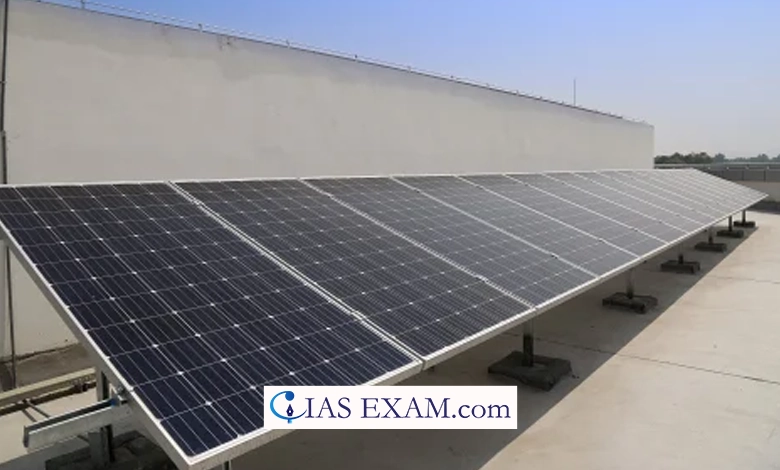Daily Current Affairs for UPSC
Trend in Solar Power Generation Potential
Syllabus- Environment [GS Paper-3]

Context
A study by the India Meteorological Department (IMD) has recently revealed a significantly decreasing trend in solar power generation potential in the country.
Key Highlights
- The study titled “Understanding the climatology and long-term trends in solar radiation the usage of ground based in-situ observations in India,” is authored by six scientists, and has been posted by IMD.
- Investigation by Authors: They investigated the climatology and trends of worldwide radiation (GR), diffuse radiation (DR), bright sunshine hours (BHS) and technical potential of solar photovoltaic power (SPV) the usage of information procured from IMD for the period 1985–2019.
- Decrease in SPV Potential: There is an alarming reducing fashion within the solar photovoltaic capability in all the chosen stations which is in all likelihood to keep in the near future as well. It would negatively impact energy manufacturing from solar sources.
- Reduction in GR: The study points towards a widespread reduction in GR in all parts of the country except the extreme northwest.
- Reduction in GR is attributed to the increased atmospheric turbidity and cloudiness.
- Increase in DR: A good sized growth in DR has been located in more than 50 percent of the stations, specifically within the northwest and some elements of peninsular India.
- Decrease in BHS: Pointing out that BHS has notably reduced in 75 percent of the chosen stations, the observation brings out that the annual BHS is high in northwest India however low in north, north-east and southern peninsular India.
- Causative Factors: Increased aerosol load — first-class debris from carbon emissions, fossil gasoline burning and dust — and clouding are said to be causative elements.
- Aerosols absorb the daylight and deflect it away from the ground and they can also precipitate the formation of dense clouds that again block daylight.
- Global Trends on Solar Radiation: The function of aerosols in blocking off daylight to be had on this planet has been obvious for the reason that 1980s, several research have proven that there are variations both over time as well as location.
- Global solar radiation confirmed a normally lowering trend from 1981-2006. 1971-2000 confirmed greater dimming compared to 1981-2006.
- However, on the whole, there was a reversal in traits after 2001 with the precise causes doubtful.
Significance of Solar Energy
- Impact on Climate of Earth: Solar radiation has an essential function in governing the earth’s surface-atmosphere energy exchange and climate of the Earth.
- It modulates global energy balance and changes the climate and hydrological cycle.
- Reliance of Various Sectors: Various sectors along with agriculture, electricity, industry, and so on. Without delay or in a roundabout way rely on the incoming solar radiation.
- Source of Clean Energy: Solar energy has been diagnosed as an alternative to traditional energy resources.
- Amongst all the clean technologies, solar energy serves as an effective renewable energy resource to mitigate greenhouse fuel emissions and reduce global warming.
- Crucial for Self Dependency: Solar power is one of the sources able to self-reliant strength technology, reducing foreign energy dependence.
Way Ahead
- The technical capacity of solar power has a notable decreasing trend in most of the selected stations that’s alarming.
- It necessitates the extensive use of sun panels with better efficiency to satisfy the energy requirements from solar resources.
Source: The Indian Express
UPSC Mains Practice Question
Q.India has immense potential of solar energy though there are regional variations in its developments. Elaborate. (2020)





.png)



